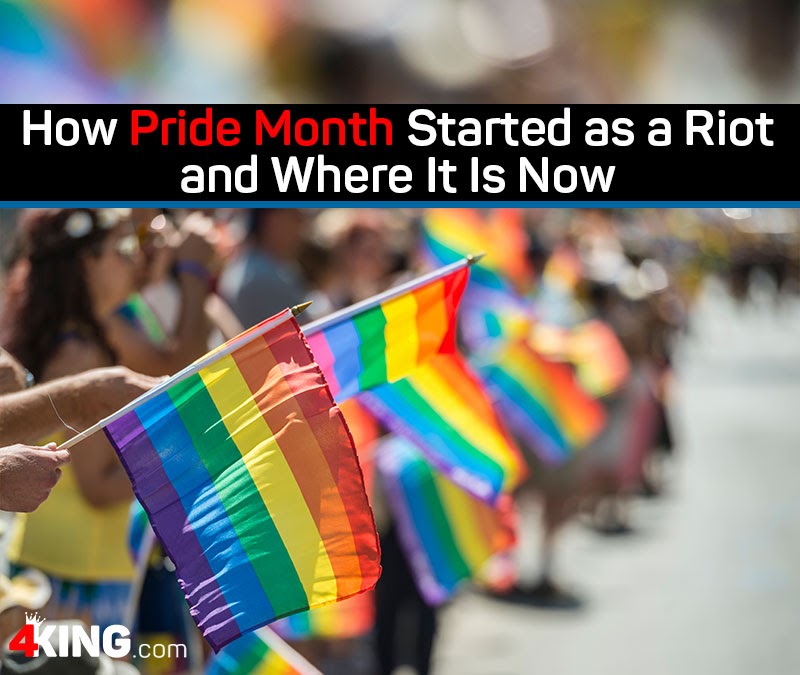June is Pride Month. Today we know it as a party, filled with Rainbow Capitalism (Ugh), faux allyship, and a whole lot of pink washing. It’s still an important celebration, but for the most part it has turned into an opportunity for businesses (and government) to garner favour with the queer community by pretending to be allies. It wasn’t always this way – just 50 years ago, our queer elders were rioting at Stonewall, led by iconic transgender women of color like Marsha P. Johnson and Silvia Rivera. We’ll be taking a look at how Pride Month started as a riot, and where it is now.
The Stonewall Riots
The Stonewall Riots began as a result of police brutality – something we’re all too familiar with in the current climate. Members of the LGBTQ+ community were targeted by a violent police raid at the famous Stonewall Inn bar in Greenwich Village. Instead of accepting the police violence, patrons of Stonewall and various other Village queer bars fought back – hard. These riots became one of the cornerstones of the gay liberation movement, as well as the current fight for LGBTQ+ rights in the USA.
Queer Americans faced an extremely homophobic and transphobic legal system in the 50s and 60s. Early queer community organizations tried to show how LGBTQ+ people could assimilate into the rest of society, favouring non-confrontational education processes. However, this proved to do little – and the protests of the late 1960s turned violent.
When you are marginalized, fighting violence with violence is sometimes all you have. You can protest peacefully for decades and not accomplish much – sometimes all that the state responds to is a form of uprising.
The Stonewall riots did not take place in a vacuum. The 1960s saw a variety of famous civil actions including the anti-Vietnam War movement, the Civil Rights Movement, Second Wave Feminism, and counterculture. Stonewall was home to some of the most vulnerable in the queer community – gay male sex workers, transgender men and women, butch lesbians, drag queens – all those who could not, or would not, assimilate into heterosexual society.
It should come as no surprise that many of the targets were people of colour. Intersectional theory shows that there are multiple facets to everyone’s identity – there is no set scale of privilege, but historic and systemic oppression has targeted queer, black, poor, and differently abled people practically since the dawn of time. Let us also not forget that the USA was founded by Puritans – and a puritanical country it remains to this day.
How Did Pride Go from Stonewall to Rainbow Capitalism?
Perhaps it is unfair to critique modern day Pride so harshly – but how is it that we young queer people have already forgotten the fight of our elders? Not just Stonewall, but the Aids crisis, the fight for Same Sex Marriage, and so many more privileges many of us now just take for granted?
Modern day Pride is fun but, outside of smaller organizations, there is little mention of the difficult history of the queer community.
Pride today is sponsored by brands like Skyy Vodka and Adidas – the Pride Island celebration in 2018 featured a range of famous musical guests and a Skyy Vodka sponsorship. Cabana packages were sold for $3,000 a pop. In 2016, Los Angeles Pride was referred to as “gay Coachella”. This in a time when most of us, in the US and around the world, are still fighting tooth and nail for our rights.
LGBTQ+ People Still Face Intense Discrimination
Under the Trump Administration, LGBTQ+ rights have been lost. The infamous bathroom bill, which requires users to use the bathroom that matches the sex on their birth certificate, is incredibly damaging to transgender people – and particularly transgender children in schools.
In July 2017, Trump tweeted that transgender people would no longer be allowed to serve in the military. Later that same year, Attorney General Jess Sessions issued a memo that the United States Department of Justice would no longer argue in court for trans people to be protected from employment discrimination on the basis of their identity.
Just this month the Trump administration has been arguing in court in favour of letting adoption organizations discriminate against same sex couples, by not allowing same sex adoptions. Do you see where this is going?
The scaling back of basic human rights is indicative of the far right nature of the current administration. LGBTQ+ people have fought for these rights for decades, only for them to be taken out from under us.
How to Better Support the Queer Community
We’ve looked at how Pride Month started as a riot and where it is now, and what can be done. We don’t need to delve into the entire history of queer identity – queer identity is intersectional, it is complex and it is comprised of many different facets in an infinite form of combinations. To say that cisgender, white gay men have it as hard as a black transgender woman of colour is false, and its why white community members must show up for our queer siblings more.
We must examine allyship from the straight and cisgender world too – much like the BLM movement, it is time to educate yourselves. Stop relying on the LGBTQ+ people around you to do all of the hard work for you. It is time to step your game up. Show up for your queer friends and family, attend protests, speak to your family, and don’t let Rainbow Capitalism lull you into a false sense of security – the work is far from over.
Donate
National Center for Transgender Equality


